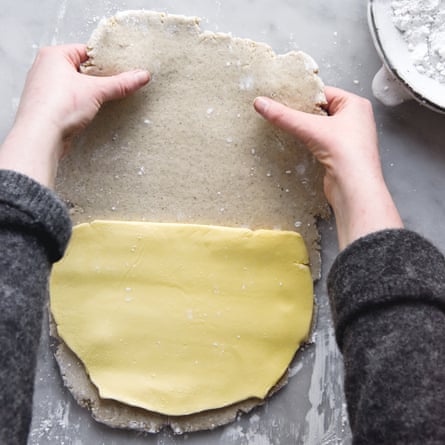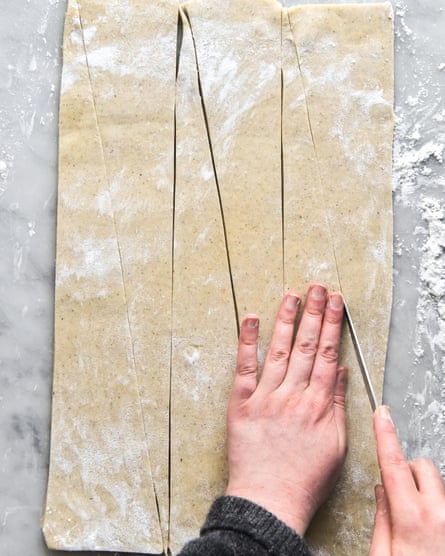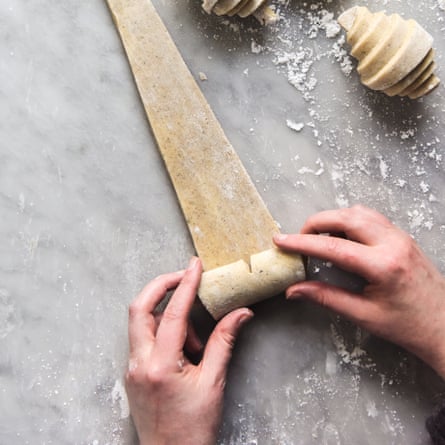Second only to my cat Arthur and my extensive photographic catalogue of him sleeping, this croissant recipe is my pride and joy. It took me nearly 100 attempts (seriously) to nail down not only the recipe, but more importantly the technique.
Croissants are fussy creatures. Proofing them is somewhat of an art and requires a lot of intuition, as it is dependent on so many factors unique to where you are baking.
They need to be hot enough that the yeast becomes active and gives the croissants lift, but cool enough that the thin sheets of butter don’t melt. The process is infinitely easier in winter when you can better control the temperature. I do not recommend making croissants in summer unless you have a cool kitchen, a willingness to fail and the patience of a saint.
While they’re certainly a labour of love and the technique takes some learning, you’ll get to eat croissants at the end. Is there anything more motivating than that?
Prep 30 min + 2–3 hr rolling
Proof overnight + 2-3 hr
Cook 15-25 min
Makes 4-6
Equipment Stand mixer
For the yeast mixture:
60ml full-cream, lactose free milk, warmed
7.5g dried yeast
1 tsp caster sugar
For the dough
120g fine white or brown rice flour
90g tapioca flour
60g buckwheat flour
½ tsp xanthan gum
1 tsp gluten-free baking powder
15g psyllium husk powder
100g caster sugar
¼ tsp fine salt
50g unsalted butter, softened
60–125 ml full-cream, lactose-free milk
2 extra-large eggs
For the beurrage (butter block)
150-200g good quality unsalted butter
To finish
1 egg, lightly beaten
Make the dough the night before. Start by making the yeast mixture. Place the warm (not hot) milk in a small bowl. Sprinkle over the yeast and sugar and mix to combine. Set aside until bubbling and foamy, about 10 minutes.
Combine the flours, xanthan gum, baking powder, psyllium, sugar and salt in the bowl of your stand mixer. Add the activated yeast. Using the paddle attachment, start mixing dough on low speed. Add the softened butter and continue mixing until combined.
Add milk and eggs and mix until a relatively thick, batter-like dough forms. Dough with less milk is easier to laminate, but dough with more milk results in a more open crumb. I recommend using less milk for a beginner, then adding more when you get the hang of the process.
The dough will be a little thinner than a traditional croissant dough, but you should be able to pick it up and scrape it out of the bowl. If not, wait 10 minutes for the psyllium husk powder to absorb some liquid.
Transfer dough on to a large piece of plastic film. Wrap to cover and press it into a rectangle shape. Chill in fridge overnight.
The next day, place the butter for the beurrage on a large sheet of baking paper and set aside to just slightly soften for 10 to 20 minutes, season dependent. Fold one side of paper over the butter block and use a rolling pin to bash the butter into a rectangle shape. Lay the butter rectangle flat in the fridge while you work on the pastry.
Using tapioca flour, generously flour a large sheet of baking paper or a clean, dry bench and both sides of your dough. Gently roll dough out into a rectangle, double the length of your butter block. The idea here is to achieve an even layer of butter between every bit of the dough layers, as this is what helps the croissants to rise.

Dust the excess flour off the pastry and place your butter block on the bottom half of the rectangle. You should be able to cleanly fold the top half over the bottom, just pinching the sides and bottom to secure the butter in the dough. Pick dough up gently to ensure the bottom has adequate flour to prevent it sticking. Place it back down with the shorter side facing you.
Using gentle and even pressure, roll the dough out into a rectangle, roughly 20 centimetres in length. The length doesn’t matter too much – it just needs to be long enough to fold into thirds. If the dough cracks or the butter feels too solid, stop rolling and wait five to 10 minutes. Similarly, if the butter starts feeling soft or seeps out, transfer it straight to the fridge.
We are trying to roll tiny, thin sheets of butter into dough (that has no gluten!) without it melting, cracking or breaking, so you really need to concentrate on even, slow and considered pressure. If you hack at the dough, you can expect a very dense and unimpressive croissant.

Dust any excess flour off the pastry. Fold the top third into the middle of the pastry and the bottom third up over the top; this is called a business letter fold. Press the dough down gently to secure with your rolling pin, before wrapping in plastic film and placing it in the fridge for 10 to 30 minutes. This is to firm the butter up, so allow more time in a hot kitchen and less in a cool one. Congratulations! You have just completed your first turn.
Complete this process of rolling, folding and dusting two more times, letting the dough soften or putting it in the fridge as often as necessary. I like to complete my turns with the seams of the dough facing up, so they fold back into the pastry. It makes for a neater dough that’s easier to handle.
More lamination is not better in the case of croissants. If you exceed three folds you are on a fast track to a very time-consuming brioche, so make sure you keep count of how many turns you have done.

Generously flour a large sheet of baking paper or a clean, dry bench with tapioca flour. Lay out the turned dough with the short side facing you. Once it warms to a good rolling temperature (you should have a sense of this by now), begin rolling it out into a long rectangle, about 7.5mm to 1cm thick, and the width of the baking paper. The longer the rectangle, the more rings you’ll get on the finished product.
Use a small, sharp, non-serrated knife to trim the edges with a clean, swift action. Blunting the edges now will squash all those beautiful layers we’ve worked hard to create. Slice the dough into four to six long triangles. Two triangles should equal one long rectangle, so that the dough starts and finishes with the straight edges.
Gently pick up the first triangle, transferring the others to the fridge if they start to stick.
Turn the triangle over, dust off any excess flour and cut a small 1-2cm slit in the centre of the wide base. Flick the two edges of the slit outwards to the edges of the dough. From here, start rolling the croissant up reasonably tightly. Once you get to the end, leave the croissant tail hanging down. Don’t tuck it underneath the croissant as you would with regular ones – if you do, the croissant will split down the middle as it bakes. Repeat with the remaining croissants.

To proof, cover your croissants completely without the covering touching the croissants. I like to divide them into ceramic baking dishes and place the dishes in giant ziplock bags. Next, consider your kitchen and weather conditions; if it’s hot, they will need less proofing time.
Place them in a temperate zone (never in direct sunlight) and check on them every so often. If you see any leaking butter, pop them straight in the fridge. If you’re baking in winter, place the ziplock-bagged croissants in the oven with either the light on or a small baking dish of hot water at the base of the oven. Change the water every hour or so, checking on the croissants as you do.
Your croissants are proofed, or close to proofed, when they feel puffy and light to the touch. They might not look as if they have expanded significantly, but the dough should feel springy and the tray of croissants a little lighter than you’d expect them to be. They might feel like crackling sherbet against your fingers when you touch them lightly.
While this might only take an hour or two in summer, it can take most of the day in a cold, wintery kitchen, so be patient and don’t panic.

Preheat the oven to 180C and line a large baking tray with baking paper, then carefully transfer the croissants to the tray. Use a small paintbrush to brush the pastry tops with beaten egg, being careful not to paint the exposed edges, which will glue the layers together and stop the croissant from rising and becoming flaky.
Transfer the croissants to the fridge for 10 minutes to chill. Bake for 15 to 25 minutes, or until golden brown and puffy. Some butter leaking is normal, but if yours are swimming, this is a sign they were under-proofed. It can also suggest that the butter wasn’t rolled into the dough with enough precision. Next time, proof them for longer and focus on even, considered rolling of the dough.
Gently transfer the croissants to a wire rack to cool. They can be eaten warmish, but I give them at least an hour to set.
This is an edited extract from Intolerance-Friendly Kitchen by Georgia McDermott, published by Lantern (RRP$34.99).

Comments (…)
Sign in or create your Guardian account to join the discussion